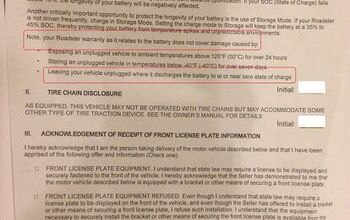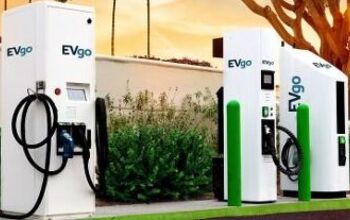Between the Lines: Chrysler's Electric Vehicle Charade
Chrysler unveiled some primo bailout bait today: three electric vehicles (EVs). Choosing CNBC as point man, ChryCo’s CEO showed-off a fully electric Dodge sports car and a Jeep and minivan hybrid. While the press has been suitably impressed, pistonheads who’ve been following (and following and following) the hoopla surrounding GM’s plug-in electric – gas hybrid Chevrolet Volt are settling-in for the long haul. Meanwhile, we must endure Auburn Hill’s spin on the whole “future vehicles” thing. Or do we? Here’s Chrysler press release…
Looking beyond hybrids…that was the mission of ENVI.
And here I thought the mission was to convince the government that Chrysler is worthy of a federal bail out. That’s why they unveiled the cars on CNBC – they are pitching Chrysler LLC to the business community as a suitable investment.
Revealed today are three electric-drive vehicles, one of which will go on sale in 2010.
One? So two-thirds of this dog and pony show is, to quote GM’s Bob Lutz, “a crock of shit?” Well, no surprise there. So which one will it be? The Jeep is no deal, right off the bat. Too low volume, doesn’t fit with brand image. So will Chrysler do it smart and build the minivan, or try to build the sports car for rich people already on the wait list for a nearly identical Tesla?
The prototypes give a glimpse of the very near future. Chrysler intends to bring advanced, electric-drive vehicles to market quickly,
They are coming very soon, do you hear us? This is not a pipe dream like that Chevy Volt, which is set to come to market in 2010 as a 2011 model. Ours are going on sale in – what did we say above? Oh, 2010 also. Nevermind.
A fleet of more than 100 Chrysler electric vehicles will be on the road in government, business and Chrysler development fleets next year.
What we’re going to do is make nice with the government (probably Santa Monica parking enforcement), then try to sell our investors by letting them drive these cars around as toys for a few months.
The Dodge EV has three primary components: a 200 kW (268 horsepower) electric motor, an advanced lithium-ion battery and an integrated power controller. The 200 kW electric-drive motor produces 480 lb.-ft. of torque, accelerating the vehicle from zero to 60 mph in less than five seconds, with a top speed of more than 120 mph.
This all sounds very familiar. Where did I hear it before? Oh right, Tesla’s website.
The Dodge EV has a range of 150 miles between recharges – more than tripe the average daily commute. To recharge the vehicle, simply plug it into a standard 110-volt household outlet. Or the recharge time can be cut in half by using a typical 220-volt household appliance power outlet.
All subject to change when we switch our design software to CAD from the current NapkinSharpieSoft. Also noteworthy: the idealistic claimed 150 mile range is less that Tesla’s idealistic claimed 244 mile range. Who is making the batteries? Who is dealing with the transmission issue that Tesla – and even partner BorgWarner – had so much trouble with? Would the car be assembled in the US or by Lotus in England?
The Jeep EV is a range-extended electric vehicle that couples the electric motor and the lithium-ion battery system with a small gasoline engine and an integrated electric generator to produce added energy. The Jeep EV has a range of 40 miles of zero-emissions, all-electric operation – no gas necessary. But for longer trips of up to 400 miles, the small gasoline engine produces energy to power the electric-drive system.
Now, since we’re done knocking off Tesla, we’ll move on to knock off the Volt. Don’t worry though. There isn’t a Snickers’ chance in Britney’s kitchen this thing will make it to production.
Since nearly 80 percent of Americans drive less than 40 miles per day, or 14,000 miles per year,
Yes, we all read the same press release from the same study, then heard Bob Lutz drop it into conversation like he thought it up in the shower. You know why people use medians instead of averages? Because averages suck.
The instant high torque and the ability to control each wheel independently results in the off-road capability consumers expect from Jeep.
Sending power to each wheel does sound very cool for off roading. So did the Jeep Rescue Concept. And the Jeep Gladiator Concept. And the Jeep JT pickup. And the Jeep Dakar concept.
The seven-passenger Chrysler EV is, like the Jeep EV, a range-extended electric vehicle that puts electric-drive technology in the segment-leading Chrysler Town & Country minivan.
Segment leading it what way? More Swivel ‘N Go than the Sienna? Leading in fleet sales?
The Chrysler EV can drive 40 miles on all-electric power, or 400 miles with the help of an integrated small displacement engine and generator. The Chrysler EV uses a 255 horsepower motor, producing 258 lb.-ft. of torque, providing zero to 60 mph acceleration in about nine seconds.
It’s a minivan. Meaning you’re supposed to fill it up with kids and hockey bags and other wholesome junk. What’s the range when there’s 1000 lbs of American goodness inside?
And so on. There’s but one takeaway here: there’s nothing to take away. Not now, and not before Chrysler is forced to face the music. Do you know it’s vaporware? No, but if you hum a few bars I can fake it.
Latest Car Reviews
Read moreLatest Product Reviews
Read moreRecent Comments
- 28-Cars-Later So now H/K motors will last longer in between scheduled replacements. Wow, actual progress.
- AZFelix I have always wondered if the poor ability of Tesla cars in detecting children was due to their using camera only systems. Optical geometry explains that a child half the height of an adult seems to have the same height as that same adult standing twice as far away from the viewer.
- 28-Cars-Later Actually pretty appealing (apparently I'm doing this now). On a similar note, a friend of mine had a difficult situation with a tenant which led to eviction and apparently the tenant has abandoned a 2007 Jag S-Type with unknown miles in the garage so he called me for an opinion. Before checking I said $2-3 max, low and behold I'm just that good with the 3.0L clocking in at $2,3 on average (oddly the 4.2 V8 version only pulls $2,9ish) and S-Types after MY05 are supposedly decent.
- DO I have owned a 2012 LR4 since day one and it has been the best vehicle I have ever had the pleasure of having in the garage. I know how easy it is to hate on Land Rover but this LR4 is comfortable, has a ton of storage room and is so versatile. With 110k miles, mine is now relegated to ‘other’ car use but is still the go to for off road adventures and snow runs. Nice to see one featured here - I think they are so underrated.
- Tane94 I'd be curious to know whether 87 octane is no longer the most popular grade of gasoline by sales volume. My Costco often runs out of Premium grade and I suspect 93 octane might now be the most popular grade of gas. Paying 40-50 cents more per gallon 87 vs 93 octane because of turbo engines is the real story


































Comments
Join the conversation
I thought I was reading a GM press release on the Volt for a minute. Seriously, who is going to take a chance on a Cry-sler EV? Just like with the Volt, does anyone think they can make a reliable EV like Toyota or Honda?